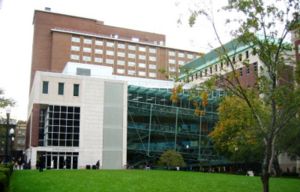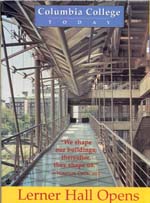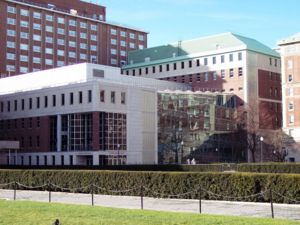Alfred Lerner Hall

Alfred Lerner Hall is the student center. It was built from 1996-1999, replacing Ferris Booth Hall, and is named for donor Alfred Lerner CC'55.
Lerner is notorious for its infuriating system of space-wasting and inefficient upward-spiralling ramps. The stairs in the 'exit' stairwells are actually the quickest way to navigate Lerner.
Contents
History

Lerner Hall came into existence when students began finding that Ferris Booth Hall didn't offer them enough space for their activities. As George Rupp had made investing in undergraduate resources a priority, the administration pursued a major gift as part of its ongoing capital campaign. With a $25 million donation in hand, the administation called in then-GSAPP dean Bernard Tschumi to choose an architect to design a new building. Tschumi's choice? Bernard Tschumi.
The design has been widely criticized for its slanted ramp structures, which are an inefficient means of moving about within the building and take up vital space - the very extra space that had been lacking in Ferris Booth. Tschumi and others justified the ramps as a social space that were supposed to respond and function just like the Low Steps. They don't.
After several years in which student groups had been exiled to a corrugated shack outside John Jay Hall, Lerner Hall opened. The administration wasted no time beginning a propaganda drive, distributing free T-shirts and other goodies with "CU on the Ramps" written on them. These were somehow supposed to encourage disinterested students to congregate on the ramps. They didn't.
Since, at least one student has proposed (successfully) on the ramps.[1]
More recently, then CCSC president Matthew Harrison tried to make Lerner cool with Glass House Rocks. This proved moderately successful - Lerner is packed, on one night. Harrison also wrote his senior thesis on the building, becoming the first known Lerner historian.
In later years, Lerner has been the focus of a tug-o-war between students and administration over the use of rooms. Spaces like the Satow Room and the Roone Arledge Auditorium are frequently taken up by admin meetings and conferences, exiling students to dorm rooms and classrooms. Lerner's empty sixth floor has become a particular bone of contention. After years of wrangling, during which the space was nearly converted into a temporary fitness center, among other uses, it was announced that the space would become...administrative offices. In 2009, the 6th floor was opened as the new office of the Dean of Students, as well as the Office of Judicial Affairs & Community Standards and the Office of Financial Aid. The space on the 4th floor vacated by the Financial Aid office is being renovated to create the Center for Student Advising.[2]
Despite such contention, the ramps have come to be a place for students to study as well as a place for organizations to advertise. Beware on weekdays if you are heading to Ferris Booth for lunch or a snack! There will be people selling baked goods. They will approach you. They will yell at you, no matter how uncomfortable you look. Avoid their gaze and make a run for it.
Funding
Lerner Hall's approximately $85 million price tag was only partially covered by donors, who raised $35 million for the center ($25 million from Alfred Lerner, $6 million from Roone Arledge, and over $1 million each from the Booth and Satow families). Barnes & Noble and Dining Services contributed $6 million to build out their spaces. The $44 million balance was covered by 24-year bonds at 6 percent interest. The debt is being repaid through a combination of student life fees on all university students (25%), a tax on every school other than Barnard (30%), and the university central administration's budget.[3]
Rooms
- Roone Arledge Auditorium
- Roone Arledge Cinema
- Black Box Theater
- Satow Conference Room
- Lerner Party Space
- 2 music practice rooms
- 5 conference rooms
- 2 ramp lounges
- 2 multi-purpose rooms
Reprogrammed spaces
Since Lerner's opening, a number spaces have been reprogrammed after the rooms either outlasted their initial purpose or were found not serve them at all. These included a game room that was converted in the Broadway Room when no one used it, an outpost of STA Travel on the first floor that's been converted into computer kiosks, a Dark Room for film development on the 5th floor that was converted into a computer publishing station[4], student group offices on the 5th floor that were converted into space for SDA and open area for meetings (that were later partially swallowed for more Student Affairs related offices) when the offices turned out to be too small to be useful, and a Credit Union teller's room that was never used, also on the fifth floor.
Finding quiet space
The piano lounge's name comes from the giant grand piano located next to the entrance. Because people are welcome to play, the lounge can sometimes be a noisy place to study. If you want peace and quiet, you could head up to some of the seating littered around the building, or down to the seating outside the Party Space entrance. Also try the Satow Room on the 5th floor, and the ramp lounges on the 2nd floor.
Dining locations
Facilities
- Mail Services
- Columbia Bookstore
- Citibank ATM
Offices
Health Services offices
- Alice! Health Promotion Program
- Office of Counseling and Psychological Services
- Office of Disability Services
Administrative offices
- Columbia Catering
- Dining Services
- Double Discovery Center
- Sexual Violence Prevention and Response Program
- Disciplinary Procedure for Sexual Misconduct (DPSM)
- Office of the Dean of Student Affairs
- Office of Financial Aid and Educational Financing
- First Year Sophomore Advising Center
- Office of Multicultural Affairs (OMA)
- Office of Student Development and Activities
- Center for Student Advising
Opening hours
| Location | Mon | Tues | Wed | Thurs | Fri | Sat | Sun |
| Lerner Hall | 7am-1am | 7am-3am | 7am-1am | ||||
| Cafe 212 | 8am-2am | 8am-9pm | 9am-9pm | 9am-2am | |||
| Ferris Booth Commons | 10am-9pm | 11am-5pm | closed | ||||
| Columbia Bookstore | 9am-9pm | 11am-6pm | |||||
| Mail Services | 9am-8pm | 9am-5pm | closed | ||||
Note: Building hours are extended to 24 hours during final exam periods. The computer lab on the second floor (campus level) remains open 24 hours at all times, though requires swipe.
References
- ↑ http://www.college.columbia.edu/cct/may03/features6.php
- ↑ Lerner 2010: A Place for Students!, Bwog, 6 May 2010
- ↑ Funding a Student Center: A University-Wide Debt, Columbia Spectator, 4 Nov 1999
- ↑ Lights Go Out on Dark Room, Columbia Spectator, 6 October 2006
External links
- Alfred Lerner Hall website
- Rants Raves and Ramps, Columbia Spectator, 8 November 1999. Spec feature examining the vast discrepancy between architectural critics' reception of Lerner Hall (positive) and that of its users (negative).
Map
<googlemap lat="40.806878" lon="-73.963569" type="map" zoom="16" width="500" height="300" controls="small"> 40.806878, -73.963569, Alfred Lerner Hall </googlemap>
